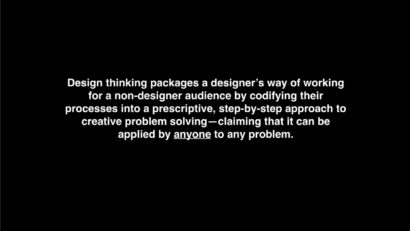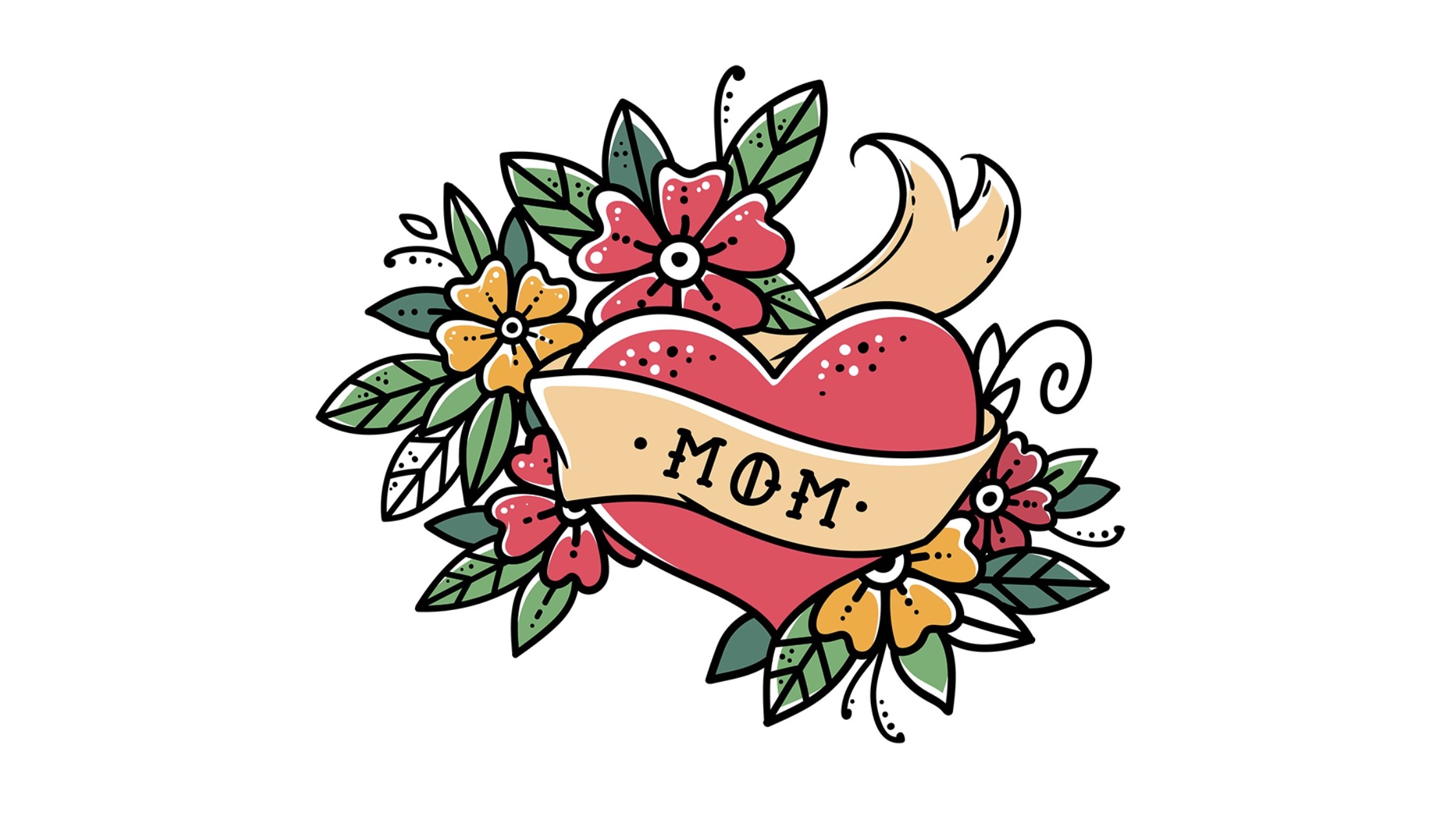In Defense of Design Thinking, Which Is Terrible

Last week I took part in the Third Annual Phil Patton Lecture, hosted by the Masters Program in Design Research at The School of Visual Arts in New York. The event is held in honor of the program’s former faculty member, design journalist Phil Patton, who passed away in 2015.
Its format is a bit unique: it begins with a feature speaker who lectures on a topic at the intersection of design, research and writing, followed by a respondent speaker who offers a counter-argument.
This year’s event was hosted by writer and filmmaker Adam Harrison Levy. The feature lecture was given by Natasha Jen, partner at Pentagram in New York, who talked about “The Designer as Critic.” At the core of her talk was a skepticism about the merits of the “design thinking” approach to problem solving. In the past, in other lectures, Jen has stated explicitly her belief that “Design thinking is bullshit.”
I presented a response which might best be titled “In Defense of Design Thinking, Which Is Terrible.” I’ve rewritten my speaker notes in more readable form below. It combines many of the themes in talks I’ve been giving for the past year alongside new ideas about design vernacular, democratization and more. You can also watch video of both lectures at designresearch.sva.edu.
It’s an honor to be on stage here, taking part in the Phil Patton lecture. What a wonderful legacy he left.
Also it’s such an honor to be on stage with Natasha, of whom I’ve been a fan for a number of years. Thank you Natasha for your address. I’m going to try my best to live up to it with some remarks of my own.
What to do with design thinking? Actually, when it comes to design thinking, I can take it or leave it. There are some great things about design thinking, but it’s also true that design thinking has its downsides.
It can be superficial, it can be misleading, and it can produce bad design. (That last concept, “bad design,” is an idea I’d like to come back to in a moment.) Even so, design thinking is still a useful lesson in how we, as designers, think about the democratization of our craft.
Before I dive too far into design thinking though, I want to talk first about technology, coding and engineering. You can’t talk about design without talking about these things. I won’t be making an apples-to-apples comparison, of course, because I’m going to be talking about engineering very broadly, and design thinking is relatively narrow—it’s just a slice of design, not the entirety. Nevertheless, engineering is useful as a proxy for discussing design being done by non-designers.
How many people here know how to code? Okay a sizable minority of you.
If you’ve ever tried to learn how to code and you weren’t trained in a computer science program at college, you know that there’s still no shortage of educational resources out there for you.
We all know the “For Dummies” series of books, which cover everything. Just as there’s a “Woodworking for Dummies,” there’s also a slew of programming-oriented titles: “JavaScript for Dummies,” “C for Dummies,” and one for just about every language out there.
Similarly you could go to a place like Khan Academy online, where you can learn to program for free, forever. Amazing.
And Apple has a wonderful product called Swift Playgrounds. It’s an app for your iPad but it’s really an environment where kids can learn to program. Apple is of course invested in getting as many people to use their technology products as they can, and in fact they promote their Swift programming language with this page on their site, with the headline “Everyone Can Code.”

“Everyone Can Code” is an interesting idea. The implication is that there will be a lot of good code out there, but it also implies that there will be a lot of bad code too. In a world where everyone can code, not all code will be good. There will be bad code, in fact.
It’s worth noting though that engineering as a discipline, as a trade, as a profession is largely unthreatened by the idea of bad code. In fact, you could say that the prevalence of bad code has been a boon to the world of engineering. In spite of all the bad code being written out there, the discipline is thriving.
This is due in part to the fact that engineering has come to be widely distributed. It’s everywhere now, in everything, and that has helped establish a cultural comfort with engineering, with its tools and, importantly, with its vernacular.
We all speak engineering now. Not just words like “gigabytes,” “megahertz” and “RAM.” Those are terms that we’ve adopted in order to better describe technology.
But we’ve also adopted technology terms as a way of describing our own world. Words like “reboot,” “bandwidth,” “offline” and “beta.” We use these words not just to talk about modern life, but also to cement the relationship between technology and our daily life.
Even numbers, which theoretically have no meaning, are influenced by this relationship. When we say “1.0” and “2.0,” we are connoting specific ideas and meanings derived from tech.
In fact, you could say that bad engineering, just like good engineering, has helped turn technology into the most powerful force for change in the 21st century. Engineering has been incredibly democratized and it’s been good for engineers. Today’s engineers are in greater demand than ever.
And yet design—and designers—seem perpetually threatened by democratization. I’ve been a designer for two and a half decades and I’ve seen this again and again.
We’ve talked for years about accreditation, the idea of licensing designers and regulating design. This would require designers to pass the equivalent of a bar exam in order to work professionally, thereby controlling the gates of who gets to practice design.
We bemoan services like 99 Designs, a marketplace for design services where designers can bid on small projects. The end result that we fear from sites like this is downward pressure on the economics of design.
And with great passion, we’ve fought the custom of spec work, in which designers and design companies do free work in the hopes of winning paid contracts. A good argument can be made against spec work, of course. But sometimes our vehement opposition to it seems to exist out of spite, like rich one-percenters incensed by the idea of social services.
And it’s this tradition that I’m reminded of when I consider the backlash against design thinking. It sounds like more of the same. It sounds territorial—like designers defending our turf.
In Natasha’s appearance at last year’s 99U conference, she offers this definition for design thinking:

When I saw that, I was immediately struck by its territoriality. I know this was not her intention, but for me the unmistakable implication was…
Only designers can do design.
And also, perhaps, only designers should do design.
To expand on this reaction, allow me to go a bit deeper into my analogy of technology.
Some of you may be familiar with Eric S. Raymond’s book “The Cathedral and the Bazaar.” This is a foundational text in the idea of open source, which is arguably the ultimate expression of democratization in modern technology.
Put somewhat simplistically, Raymond’s book argued that there is a dichotomy of approaches to software development.
There’s the cathedral model, in which software and technology are solely the domain of the developer. If you think about early computing in the 1960s and 1970s, in order to participate in digital technology, you’d usually have to drive to a computer center where huge mainframes were housed, a kind of cathedral of technology administered by a priesthood of computer scientists.
In the bazaar model, by contrast, software is iterated on in public view, and everyone is able to participate. Technology happens everywhere in the bazaar, and this approach is in part why we have supercomputers in our pockets, on our wrists, and available everywhere we go.
Now, when I think about this particular part of Natasha’s quote…
…Claiming that it can be applied by anyone to any problem
…it sounds like that same tension between a cathedral model and a bazaar model. It suggests that design, when it’s practiced out in the wild, is problematic, is superficial, is misleading, leads to bad design. And it also implies that good design is practiced by only “real” designers, under controlled circumstances, addressing only worthy problems.
Now when we listen to arguments like this for the sanctity of the design cathedral—or the fallacy of the design bazaar—it’s important to keep in mind how the business of design has traditionally worked. Put simply, there has long been an economic incentive for designers, especially in studios and agencies, to shroud design itself in secrecy, to obfuscate the particulars of its methods. Maybe even moreso, there is an economic incentive to promote designers as “genius inventors,” singular talents who are uniquely able to channel the spirits of “good” work—priests in the cathedral of design.
Designers want design to be an exclusive domain. They want its processes to be mysterious, and often rooted in the idiosyncrasies of mercurial creative directors and savants, because it preserves the perceived value of our craft. Put more plainly: the more difficult design is to practice, the more lucrative it is for practicing designers.
But, as the dichotomy of the cathedral and the bazaar implies, if you have an idea—a force of nature—like technology, it becomes most powerful when it’s democratized, when it gets out there into the world and in the hands of millions of people.
I believe this is true of design, too.
Any embrace of design by non-designers is a good thing, and design thinking qualifies here. The reason for this is that when that happens, it means our language, the vocabulary of design, is broadening to the rest of the world.
This is important because relatively little of the world of design has crept out into the world at large, out beyond our professional circles. Those who aren’t already clued into the parlance of design don’t have the language to talk about what it is that design does and can do. There are few if any design counterparts to words like “reboot,” “bandwidth,” “offline,” and “beta”—those words that I mentioned earlier which have earned their places in the common vernacular. And when you lack language, you also lack the capacity to understand.
Now another question for the audience: how many of you are designers? From the show of hands, it looks like most of you.
And how many of you have been able to successfully explain what you do to your mom?

That question always incites chuckles. We joke inveterately about our mothers and fathers’ inability to understand what it is that we do. The humor comes from love of course, because we imagine they’ll never understand. But when we settle for that circumstance, when we accept it without contest, we’re effectively abdicating our responsility to explain design to the world at large—not just a responsibility but an opportunity to do so.
By evolutionary design, our mothers and fathers are predisposed to rooting for us, to trying to understand what it is that we do, to champion what we do. If designers are looking for advocates amongst non-designers, parents should be an easy win. But if we can’t explain it to our mothers and fathers, we’re doing something wrong.
So if we’re not talking to our parents when we’re talking about design, to whom are we talking? To whom is our critical discourse aimed?
The answer is obvious: ourselves. And that’s pretty much it.
Designers are most comfortable defining design to one another, to discussing design only with initiated peers who already have the vocabulary to talk about the work. You can see this in almost anything anyone ever publishes about design; the audience is almost always people who are more or less just like us.

Now at this point it’s worth noting that today, March 28, 2018, is the first time that Natasha and I have ever met. In some respects it’s surprising that it took so long because we’re both residents of New York City, we’re both designers, and we have plenty of mutual friends.
Design is a small community. Most of us, I would say, are just one or two degrees of separation apart from one another. And the smallness of that community has profound repercussions on who talks about design.
Most of what gets written about design, most of what gets read, and certainly most of the discussion around design, amounts to designers talking to other designers.
In some respects that’s a good thing. The design community is wonderful about sharing our knowledge with one another, talking about our process, and pushing our craft forward. We’re generally open and welcoming, if only to other designers.
But this has its downsides. And it’s not just that we’re insular and that our language is obscure, either. No, it’s worse: the smallness of our community compromises our discourse.
We all know each other, and if we don’t, we know that we might know one another soon.
We might hire someone we know. We might be hired by someone we know. We might pitch business to someone we know. We might attend a conference and sit next to someone we know in the audience or on a panel. We might even find ourselves on stage at an SVA event with someone we’ve just met, with whom we have many friends in common.
That familiarity, that closeness, can have a chilling effect on what it is that we’re willing to say. It prevents us from talking openly and honestly. It constrains our discourse.
Actually in some ways I’m grateful that Natasha and I didn’t know one another before this evening. It’s easier to talk frankly and to make honest points because we’re not friends. (Though Natasha, I do hope we’re friends after this. If you want to take a wait-and-see attitude though, I understand.)
However, this lack of independence in design discourse is really, really problematic if you think about it. Imagine if other art forms worked this way.
Consider Michael Kimmelman, architecture critic at The New York Times. He nearly won a Pulitzer for his incisive writing which puts architecture in context, gives it meaning and makes it more relevant for countless people.

Now imagine if Kimmelman were a practicing architect. Imagine that he has projects all over the world and is working on a huge high rise in downtown Manhattan at the same time as he files his bylines at The Times. That would undoubtedly and profoundly change the way we think about what he has to say about architecture.
Think about more “populist” arts, too. Gene Siskel and Roger Ebert, who rose to prominence as film critics in the 1970s. They used to have a syndicated television show and for years they would come into our homes every week and talk not just about what was in theaters but also about the ideas behind film. In doing so they turned us all into better informed, more passionate moviegoers.

What if Siskel had been a working film producer too? Or if Ebert was a screenwriter and director at the same time as he was a critic. The effect would have been that they would have both been far, far less influential than they were, and we’d all be poorer for it.
That hypothetical scenario happens to be exactly the situation that design finds itself in today—we have a heavily compromised discourse. Just about everything that gets written about design, every robust discussion about design is constrained from being truly honest, truly open, and from truly pushing the profession towards greater relevance to the world at large.
I might even argue that in a more ideal world, Natasha shouldn’t be here tonight giving a lecture in honor of Phil Patton. And I would certainly argue that I shouldn’t be up on stage here either. For all you know, I could be just really craftily trying to sell you on Adobe software.
Who should be here? An independent voice, a critic whose job it is to think and talk about and interrogate design. Someone whose income is not derived from the practice of design, whose agenda is clear and unbiased when it comes to interrogating design’s practices, its implications, and its people.
Unfortunately we don’t have a lot of independent design critics. This is true for a host of reasons. And whether it’s a cause or an effect, the fact of the matter is that design discourse is dominated by designers, and that is a major defect of our industry.
I offer this complaint not just because I long for our craft to be taken more seriously as an art form (which I do). This is about more than recognition.
It’s also about how vitally important it is for designers to contribute at this very moment in history.
If you Google the term “tech backlash” you’ll get no shortage of results that reference this pivotal moment in the relationship between people and the digital world we’ve all been building the past few decades.
There are headlines about how people are re-evaluating how they interact with Facebook, Google and Twitter. There are widespread concerns about the massive amounts of data that have been compiled about all of us, all with worrisome opaqueness. Even the devices we love, like the powerfully liberating smartphones we all carry around, are now seen as having potentially damaging effects on our mental health. And of course there is alarm at the way that our social media activities have basically been weaponized against us and against democracy.
The world at large and maybe even many of the people in this room think of these purely as tech problems. But upon deeper reflection I bet that many if not all of you would agree that these are just as much design problems as they are tech problems. And you’d likely all agree that designers can—and should—contribute to the solutions for these challenges.
However if you Google “design backlash” the results are dramatically different. You’ll get almost none of those stories about this moment in history. Just a random selection of results that happen to include the words “design” and “backlash” on the same page.
That is as stark as any an illustration of how little the world understands design, how little it values design, how little it thinks of design as a critical factor in changing the world.
We all know that impression is wrong. We’ve been arguing the exact opposite for decades. We’ve been relentlessly advocating for the importance of design.
But the way we’ve been arguing has been counterproductive.
Our insular discourse, the way we’ve jealously protected the language and tools of design, the way we’ve focused so much on the “genius designer”… these behaviors have all worked against our own interests.
They’ve limited us, limited the opportunities we get to contribute to the fullest of our ability. And they’ve limited our capacity to fulfill design’s true potential as the world-changing force that we’ve all been insisting that it is.
So when I consider design thinking, it matters less to me whether it leads to a lot of bad design or not. What matters to me is whether it helps broaden the language of design, if it helps expand the community of design, if it helps build a world that values and understands design better than it does today. If design thinking is making us more relevant to the world at large, leading non-designers to embrace the way designers think, then the net effect strikes me as positive.
So design thinking? Sure.
I’d be happy to have, alongside design thinking, the idea of “design feeling” too.
“Design sleeping”? “Design eating”? Bring it on.
Ultimately debates like this are about a simple question: what do we want design to be?
Do we want it to be as small as it is today, an insular community with an obscure language that largely gets ignored by the world at large? Or do we want it to be as big and influential and as inspiring as we all know it can be?
Thank you.
